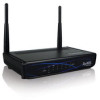ZyXEL X650 User Guide - Page 149
ISP Gateway Address, MAC Address
 |
View all ZyXEL X650 manuals
Add to My Manuals
Save this manual to your list of manuals |
Page 149 highlights
1's followed by consecutive trailing 0's, such as 11111111.11111111.11111111.00000000. Therefore, sometimes a network mask can also be described simply as "x" number of leading 1's. When both are represented side by side in their binary forms, all bits in the IP address that correspond to 1's in the network mask become part of the IP network address, and the remaining bits correspond to the host ID. For example, if the IP address for a device is, in its binary form, 11011001.10110000.10010000.00000111, and if its network mask is, 11111111.11111111.11110000.00000000 It means the device's network address is 11011001.10110000.10010000.00000000, and its host ID is 00000000.00000000.00000000.00000111. This is a convenient and efficient method for routers to direct IP packets to their destinations. ISP Gateway Address: (see ISP for definition). The ISP Gateway Address is an IP address for the Internet router located at the ISP's office. ISP: ISP stands for Internet Service Provider. An ISP is a business that provides connectivity to the Internet for individuals, businesses, or organizations. LAN: LAN stands for Local Area Network. A LAN is a group of computers and devices connected together in a relatively small area (such as a house or an office). Your home network is considered a LAN. MAC Address: MAC stands for Media Access Control. A MAC address is the hardware address of a device connected to a network. The MAC address is a unique identifier for a device with an Ethernet interface. It is comprised of two parts: 3 bytes of data that correspond to the Manufacturer ID (unique for each manufacturer) and 3 bytes that are often used as the product's serial number. NAT: NAT stands for Network Address Translation. This process allows all of the computers on your home network to use a single IP address. Using the X650's NAT capability, you can access the Internet from multiple computers on your home network without having to purchase additional IP addresses from your ISP. Port: Network clients (LAN PC) use port numbers to distinguish between different network applications/protocols. Below is a list of common applications and protocols/port numbers: 147













